BOP surplus widens to $11.8 billion

MANILA, Philippines — The country’s balance of payments (BOP) surplus further widened by nearly 88 percent to $11.78 billion from January to November compared to $6.27 billion in the same period last year on the back of strong foreign exchange inflows, as well as a smaller trade deficit due to the impact of the pandemic, according to the Bangko Sentral ng Pilipinas.
BSP Governor Benjamin Diokno said the current BOP surplus was supported mainly by higher net foreign borrowings by the national government and lower merchandise trade deficit, along with sustained net inflows from personal remittances, foreign direct investments, and trade in services.
The BOP is the difference in total values between payments into and out of the country over a period.
A surplus means more foreign exchange flowed into the country from exports, remittances from overseas Filipinos, business process outsourcing earnings and tourism receipts than what flowed out to pay for the importation of more goods, services and capital.
The BOP surplus peaked at $15.24 billion in 2010 before narrowing to $11.4 billion in 2011.
For November alone, Diokno said the country booked a BOP surplus of $1.47 billion or 2.7 times the $541 million surplus recorded in the same month last year.
The Philippines has been booking a BOP surplus for the past 10 months or since February.
“The BOP surplus in November reflected inflows mainly from the BSP’s foreign exchange operations and income from its investments abroad,” the BSP chief said.
The inflows, Diokno said, were partly offset by the national government’s withdrawals to pay its foreign currency debt obligations.
Latest data from the Philippine Statistics Authority (PSA) showed the country’s trade deficit was cut by almost half to $17.92 billion as of end-November this year from $34.05 billion in the same period last year due to the impact of the COVID-19 pandemic on global trade.
Imports dropped by 25 percent to $70.04 billion during the 11-month period compared to last year’s $94.6 billion, while exports booked a double-digit declined of 12.5 percent to $52.1 billion from $59.5 billion.
Cash remittances coursed through banks slipped by 0.9 percent to $24.63 billion from January to October compared to last year’s $24.86 billion, while personal remittances contracted by one percent to $27.35 billion from $27.61 billion.
On the other hand, net foreign direct investment (FDI) inflows declined by 8.6 percent to $4.83 billion in January to September from $5.29 billion in the same period last year.
Rizal Commercial Banking Corp. chief economist Michael Ricafort said BOP surpluses could be sustained at relatively high levels in the coming months, consistent with and helping gross international reserve (GIR) reach new record highs.
“Sustained BOP surpluses to fundamentally lead to record high GIR into uncharted highs well above latest new record high of $104.5 billion that have structurally supported the appreciating trend of the peso exchange rate versus the US dollar in recent weeks,” Ricafort said.
Aside from remittances back to pre-COVID levels and continued rise in FDIs, Ricafort also cited the proceeds of the higher foreign borrowings by the national government to finance COVID-19 response measures as the reason behind the widening BOP surplus.
The BSP is now looking at a wider BOP surplus of $12.8 billion or 3.4 percent of gross domestic product (GDP) instead of $8.1 billion or 2.2 percent of GDP this year due to the expected recovery in the local and global economies next year, a smaller trade deficit, the resilience of overseas Filipino workers remittances and foreign direct investments as well as the continued build-up of the GIR.
The central bank also expects the country’s foreign exchange buffer to hit $105 billion this year and $106 billion next year.
- Latest
- Trending


























